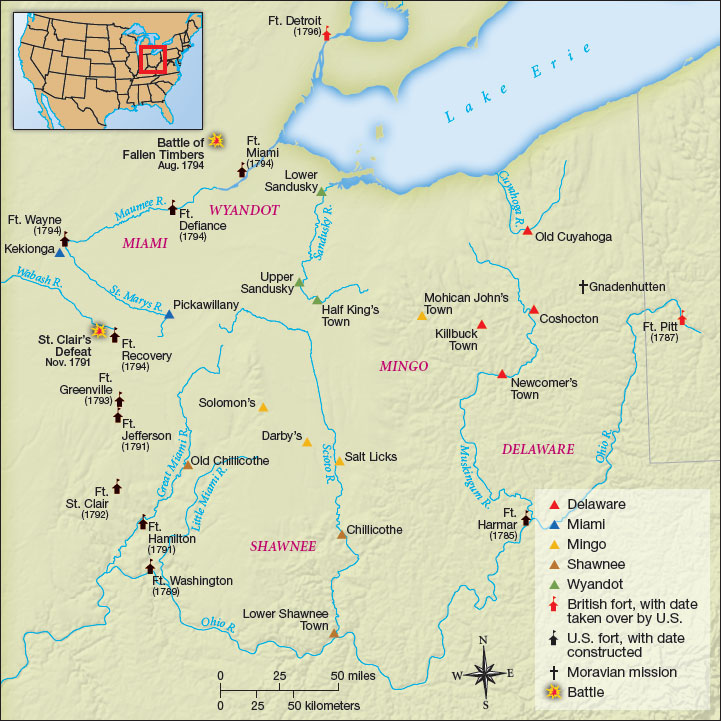Exploring American Histories: Printed Page 211
Exploring American Histories, Value Edition: Printed Page 182
Further Conflicts on the Frontier
In one area, Federalists and Democratic-Republicans voiced common concerns: the continued threats to U.S. sovereignty by Indian, British, and Spanish forces. In 1790 Congress had passed the Indian Trade and Intercourse Act to regulate Indian-white relations on the frontier and to ensure fair and equitable dealings. However, the act was widely ignored. Traders regularly cheated Indians, settlers launched private expeditions to claim Indian lands illegally, and government agents approved sham treaties. Federal troops sent to the Northwest Territory to enforce the law ended up fighting against the Indians.
The government’s failure to stem the flood of settlers into the Ohio and Mississippi River valleys proved costly. In 1790 Little Turtle, a war chief of the Miami nation, gathered a large force of Shawnee, Delaware, Ottawa, Chippewa, Sauk, Fox, and other Indians. This pan-Indian alliance successfully attacked federal troops in the Ohio valley that fall. A year later, the allied Indian warriors defeated a large force under General Arthur St. Clair, governor of the Northwest Territory (Map 7.2). The stunning defeat shocked Americans, who continued to blame British forces encamped in forts on U.S. soil for encouraging Little Turtle and his warriors. In the meantime, Spanish authorities negotiated with Creeks and Cherokees to attack U.S. settlements on the southern frontier.

Washington decided to deal with problems in the Northwest Territory first, sending 2,000 men under the command of General Anthony Wayne into the Ohio frontier. In the spring of 1794, Wayne’s troops built Fort Defiance in the heart of Ohio territory. Augmented by several hundred mounted Kentucky riflemen, Wayne’s forces then attacked some 1,500 to 2,000 Indians gathered at a nearby British fort. In the Battle of Fallen Timbers, the pan-Indian forces, led by Little Turtle, suffered a bitter defeat. A year later, the warring Indians in the Northwest Territory signed the Treaty of Greenville, granting the United States vast tracts of land.
Amid this turmoil, in November 1794 the Senate finally approved the Jay Treaty with Great Britain, which required the withdrawal of British forces from U.S. soil by 1796. But it also required Americans to make “full and complete compensation” to British firms for debts outstanding at the time of the American Revolution and limited U.S. trade with the British West Indies. Before Jay’s controversial treaty took effect, Spain agreed to negotiate an end to hostilities on the southern frontier of the United States. Envoy Thomas Pinckney, a South Carolina planter, negotiated the treaty, which recognized the thirty-first parallel as the boundary between U.S. and Spanish territory in the South and opened the Mississippi River and the port of New Orleans to U.S. shipping. The Pinckney Treaty, ratified in 1796, advanced the interests of the South, while the Jay Treaty promoted those of the North.
Review & Relate
|
How did events overseas shape domestic American politics in the 1790s? |
What common concerns underlay the Whiskey Rebellion and Shays’s Rebellion? How did the U.S. government deal differently with each? |